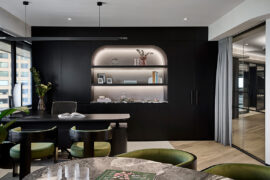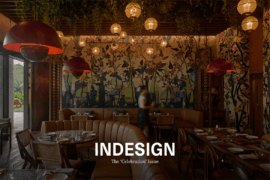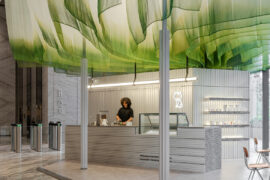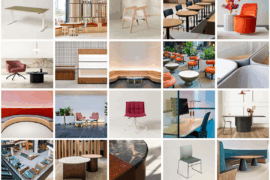Interior Design and Management Solutions company PTID has designed the interior of the new Sydney office of gambling-led entertainment company Tabcorp in the city’s CBD. The final stage of the four-floor fitout is a full floor of open work environment cleverly utilising Agile methodologies to present a compelling and intelligent design.
Tabcorp’s relocation to a CBD site provided an opportunity for a major cultural change. The new accommodation provides 5,400 square metres of totally open work environment supporting a diverse range of work styles based on a detailed strategic accommodation brief. PTID was given the task of designing a full floor extension to the company’s new premises with a design that was directly derived from Agile management (Scrum) methodologies.
But what exactly are Agile management methodologies? Agile training specialist CPrime describes the process as “a disciplined project management process that encourages frequent inspection and adaptation, a leadership philosophy that encourages teamwork, self-organization and accountability”.
The design team adopted numerous aspects of the Agile methodology in developing the concept. Given two weeks to prepare, the team took time out every two to three days to review their progress, reject unsuccessful elements and identify the minimum viable product to take forward into the next stage of the design. Karen Fairfax, Designer and Senior Associate of PTID said: “The brief from the client was articulated in very clear operational terms which gave us liberty to develop a powerful occupant experience around a highly effective workplace. The concept was presented in an evolutionary context from initial sketches to planning elements, a fully resolved floor plan followed by an animated 3D fly-through of the entire fitout. It was a compelling presentation with a strong narrative thread that leant robustness to the concept”.
Tabcorp’s floor plan responds to a highly structured series of tasks undertaken in strictly controlled timeframes by highly qualified professionals acting in defined teams with a mix of dynamic collaboration and intense concentration. The space is layered to provide a range of acoustic scenarios but with high visibility through and across the floor. Level 32 was developed as an extension to three floors of fitout previously designed by PTID with a strong brand overlay developed by PTID’s own team. “This element of the user experience was seen as a linking device between the new and the previous accommodation. The graphic design elements are a reference to the company’s sporting culture and the colours of race day and provide continuity against a backdrop of contrasting design concepts” Fairfax said.
It is projects like these, undertaking particular methodologies such as the Agile or Scrum processes that lead to the question, how do designers manage and navigate the “change management” aspect of their roles? Fairfax said: “As designers with a constant eye on the development of workplace trends, we are fortunate in being able to observe our clients operate their accommodation throughout the term of their lease. This gives us a unique perspective on how people adapt to new environments and how they adapt the environments to their needs over time. When advising clients about preparing for change, we can provide the context of the longer term to give priority to issues that are more likely to be of immediate criticality.” It is clear that the designers at PTID did not only utilize their skills as designers, but that of deep understanding of the client and environment itself.
INDESIGN is on instagram
Follow @indesignlive
A searchable and comprehensive guide for specifying leading products and their suppliers
Keep up to date with the latest and greatest from our industry BFF's!
The new range features slabs with warm, earthy palettes that lend a sense of organic luxury to every space.

It’s widely accepted that nature – the original, most accomplished design blueprint – cannot be improved upon. But the exclusive Crypton Leather range proves that it can undoubtedly be enhanced, augmented and extended, signalling a new era of limitless organic materiality.

How can design empower the individual in a workplace transforming from a place to an activity? Here, Design Director Joel Sampson reveals how prioritising human needs – including agency, privacy, pause and connection – and leveraging responsive spatial solutions like the Herman Miller Bay Work Pod is key to crafting engaging and radically inclusive hybrid environments.

Setting the tone for McCormack’s HQ is Elton Group’s Eveneer WoodWall and Eveneer Raw in Ravenna – wrapping walls, ceilings and bespoke joinery in a dark, matte elegance. The seamless pairing delivers a cohesive, high-performance finish that anchors Studio 103’s luxurious, hotel-inspired workplace design.

The latest print magazine is about to arrive! With Guest Editor Colin Seah of Ministry of Design (MOD), Singapore flooding our world with love, we are ready to party in style!
The internet never sleeps! Here's the stuff you might have missed

From a Paddington studio to the streets of Paris, with the odd Irish rural pub in between, the founder of Smac Studio shares her inspiration in design.

Spacemen Studio foregrounds fabric and colour in a hospitality project inspired by the ritual preparation of matcha.

With a bold, singular vision and a new factory just around the corner from their Western Sydney manufacturing heartland, Maxton Fox’s evolution takes the best of its history while setting its eyes on the future – and keeping its feet firmly planted on Australian soil.